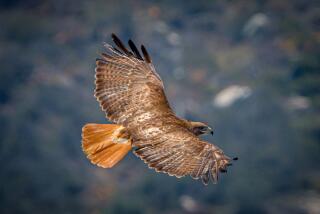In Appalachia, a Sanctuary for Raptors Spreads Its Wings : Wildlife: The Hawk Mountain site has detailed the migration of birds of prey. Now its staff is working on a global scale.
- Share via
KEMPTON, Pa. — It was past noon at Hawk Mountain Sanctuary, and bird counter Jim Brett had spotted only a lone broad-winged hawk.
Then the rain broke, and hundreds of swallows flew out of the clouds.
“This merlin just appeared through the swallows and they scattered,” said Brett, curator of the sanctuary.
Some days thousands of hawks, falcons and eagles fly over Kittatiny Ridge in the northern Appalachians. Other days there are just a few, floating on bubbles of heated air called thermals and catching updrafts of western winds.
Each gets counted by staff members and volunteers on duty from mid-August through mid-December, continuing a tradition that started with the first Hawk Mountain curator, Maurice Brown, 59 years ago. The counting has produced the most detailed records of raptor migration in the world.
A year after a sharp-shinned hawk became the millionth recorded raptor at Hawk Mountain, the sanctuary’s mission has expanded way beyond the Appalachians into Canada and South America.
The 2,200-acre sanctuary was founded in 1934 after an amateur ornithologist visited the popular hunting site 60 miles northwest of Philadelphia and took pictures of hundreds of dead hawks, stirring conservationists.
Today, more than 70,000 people visit the sanctuary annually, some just for the view of mountains, farmland and the Little Schuylkill River, others as a detour off the Appalachian Trail half a mile away.
The sanctuary’s records have been put to use by numerous conservationists and researchers, including Rachel Carson, who referred to them in “Silent Spring,” her landmark work on the effect of DDT and other pesticides.
The records enable Hawk Mountain to predict what times of year certain species are most likely to show up and also to track long-term changes in populations, which generally are up since most uses of DDT were outlawed in 1972.
“Such fluctuations have implications for humans, because as bio-indicators at the top of the food chain, raptors reflect the health of the ecosystem,” said research director Keith Bildstein.
For the last four years, the numbers of sharp-shinned hawks have been in decline after rising to higher levels than those recorded before the introduction of DDT. Hawk Mountain researchers are working with other institutions to investigate the cause.
Hawk shooting no longer occurs in Pennsylvania or anywhere in the United States on a large scale, due partly to laws promoted by the sanctuary to protect birds of prey. The Pennsylvania Game Commission’s $5 bounty on goshawks is long gone, along with the once-common view that hawks were vermin that killed domestic stock and game birds.
Now the sanctuary is working to protect hawks elsewhere in the world. More than 100,000 migratory raptors are killed for sport annually in Malta, Taiwan, Argentina and Colombia, according to Hawk Mountain researchers.
The sanctuary has initiated an international project called Hawks Aloft Worldwide to track and protect migratory raptors. The project, so far involving more than 1,500 people on six continents, is charting significant migration corridors and will publish an atlas of watch sites.
Eleven new sites already have been identified in Latin America through the project, Bildstein said.
Hawks Aloft also will coordinate training for watch-site managers and promote site visits “where appropriate” by eco-tourists, he said. A 1991 study indicated a $5-million-a-year economic benefit from birding and eco-tourism at popular watch sites in Point Pelee, Ontario, and Cape May, N.J.
A model program, in cooperation with HawkWatch International of Albuquerque, N.M., and several Mexican conservation organizations, provided training at Hawk Mountain to conservationists from Veracruz, Mexico, where 2.5 million migrating raptors were counted last fall and 400,000 during a 45-day period in spring, 1991.
In Colombia, Hawk Mountain staffers are working with governmental and non-governmental agencies to stem an annual hawk slaughter by local residents who believe shooting them hastens the passage of Lent, Bildstein said. The plan is to develop a festival to celebrate the migration in the way people mark the return of swallows to San Juan Capistrano.
Meanwhile, the watch continues at Hawk Mountain, where eagles draw applause when they come into view.
Brett, however, said his favorite is the sharp-shinned hawk. “It’s so pugnacious, fearless. I like to see them undaunted by the size of a golden eagle, swooping down on it and badgering it.”
Counting Hawks
Major species counted at North Lookout at Hawk Mountain Sanctuary near Kempton, Pa., 1934-91.
Species Annual Record Average (Year) Osprey 338 872 (1990) Bald Eagle 45 116 (1950) Northern Harrier 225 475 (1980) Sharp-Shinned Hawk 4,268 10,612 (1977) Cooper’s Hawk 264 786 (1989) Northern Goshawk 70 347 (1972) Red-Shouldered Hawk 247 468 (1958) Broad-Winged Hawk 8,742 29,519 (1978) Red-Tailed Hawk 3,231 6,208 (1939) Rough-Legged Hawk 10 31 (1961) Golden Eagle 45 98 (1987) American Kestrel 354 839 (1989) Merlin 29 157 (1989) Peregrine Falcon 22 51 (1989)
Source: Associated Press
More to Read
Sign up for Essential California
The most important California stories and recommendations in your inbox every morning.
You may occasionally receive promotional content from the Los Angeles Times.













